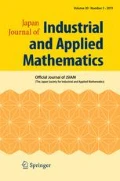Abstract
We present an iterative procedure to generate first-principles, norm-conserving pseudopotentials which are of an analytic form and separable by construction with fewer nonlocal projectors than conventional ones. The procedure consists of two steps: First, reference pseudowavefunctions and eigenvalues for an atom are determined by a conventional method. Second, trial pseudowavefunctions and eigenvalues are calculated for the pseudopotentials with adjustable parameters repeatedly until they match the reference ones within some tolerance. The pseudopotentials allow us to evaluate Hamiltonian matrix elements efficiently and less likely to yield spurious solution. Examples for copper and zinc are shown.
Similar content being viewed by others
References
D.C. Allan and M.P. Teter, Nonlocal pseudopotentials in molecular-dynamical density-functional theory: application to SiO2. Phys. Rev. Lett.,59 (1987), 1136–1139.
R. Car and M. Parrinello, Unified approach for molecular dynamics and density-functional theory. Phys. Rev. Lett.,55 (1985), 2471–2474.
E.R. Davidson, The iterative calculation of a few of the lowest eigenvalues and correspond- ing eigenvectors of large real symmetric matrices. J. Comput. Phys.,17 (1975), 87–94.
S. Goedecker, M. Teter and J. Hutter, Separable dual-space Gaussian pseudopotentials. Phys. Rev. B,54 (1996), 1703–1710.
X. Gonze, R. Käckell and M. Scheffler, Ghost states for separable, norm-conserving,ab initio pseudopotentials. Phys. Rev. B,41(1990), 12264–12267.
X. Gonze, R. Stumpf and M. Scheffler, Analysis of separable potentials. Phys. Rev. B,44 (1991), 8503–8513.
G.H. Golub and C.F. van Loan, Matrix Computations. The John Hopkins University Press, Baltimore, MD., 1993.
D.R. Hamann, M. Schlüter and C. Chiang, Norm-conserving pseudopotentials. Phys. Rev. Lett.,43 (1979), 1494–1497.
J. Ihm, A. Zunger and M.L. Cohen, Momentum-space formalism for the total energy of solids. J. Phys. C,12 (1979), 4409–4422.
G.P. Kerker, Non-singular atomic pseudopotentials for solid state applications. J. Phys. C,13 (1980), L189–194.
L. Kleinman and D.M. Bylander, Efficacious form for model pseudopotentials. Phys. Rev. Lett.,48 (1982), 1425–1428.
G. Kresse and J. Hafner, Norm-conserving and ultrasoft pseudopotentials for first-row and transition elements. J. Phys. C,6 (1994), 8245–8257.
V.L. Moruzzi and C.B. Sommers, Calculated Electronic Properties of Ordered Alloys: A Handbook. World Scientific, River Edge, NJ., 1995.
M.C. Payne, M.P. Teter, D.C. Allan, T.A. Arias and J.D. Joannopoulos, Iterative minimization techniques forab initio total-energy calculations: molecular-dynamics and conjugate gradients. Rev. Mod. Phys.,64 (1992), 1045–1097.
WE. Pickett, Pseudopotential methods in condensed matter applications. Comput. Phys. Rep.,9 (1989), 115–197.
A.M. Rappe, K.M. Rabe, E. Kaxiras and J.D. Joannopoulos, Optimized pseudopotentials. Phys. Rev. B,41 (1990), 1227–1230, erratum, Phys. Rev. B,44 (1991), 13175–13176.
Y. Saad, Numerical Methods for Large Eigenvalue Problems. Manchester University Press, Oxford Road, Manchester, UK, 1992.
Th. Starkloff and J.D. Joannopoulos, Local pseudopotential theory for transition metals. Phys. Rev. B,16 (1977), 5212–5215.
W.J. Stevens, H. Basch and M. Krauss, Compact effective potentials and efficient shared-exponent basis set for the first- and second-row atoms. J. Chem. Phys.,81 (1984), 6026–6033.
W.C. Topp and J.J. Hopfield, Chemically motivated pseudopotential for sodium. Phys. Rev. B,7 (1973), 1295–1303.
N. Troullier and J.L. Martins, Efficient pseudopotentials for plane-wave calculations. Phys. Rev. B,43(1991), 1993–2006.
N. Troullier and J.L. Martins, Efficient pseudopotentials for plane-wave calculations II. Operators for fast iterative diagonalization. Phys. Rev. B,43 (1991), 8861–8869.
Author information
Authors and Affiliations
About this article
Cite this article
Sawamura, A., Keishi, T. & Kaji, M. Iteratively generated pseudopotentials in electronic structure calculations. Japan J. Indust. Appl. Math. 17, 265 (2000). https://doi.org/10.1007/BF03167347
Received:
Revised:
DOI: https://doi.org/10.1007/BF03167347




